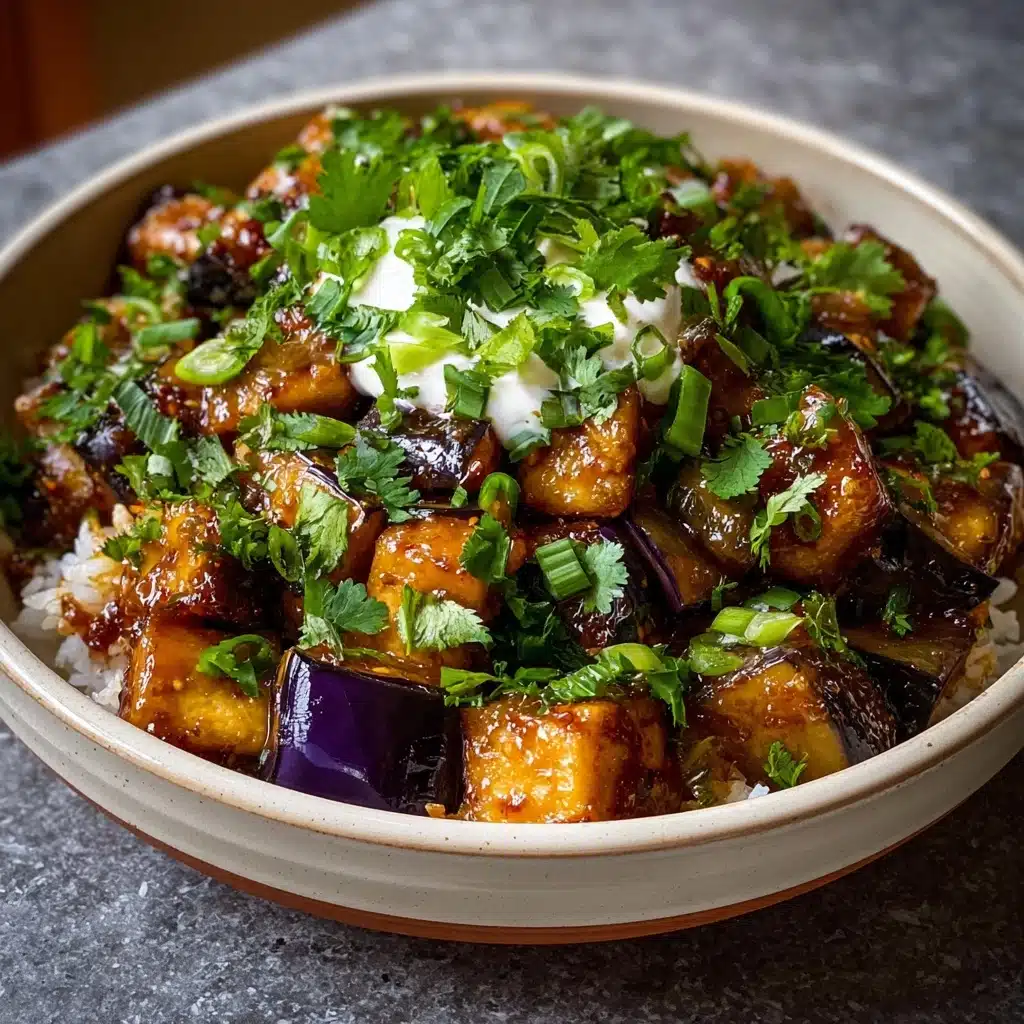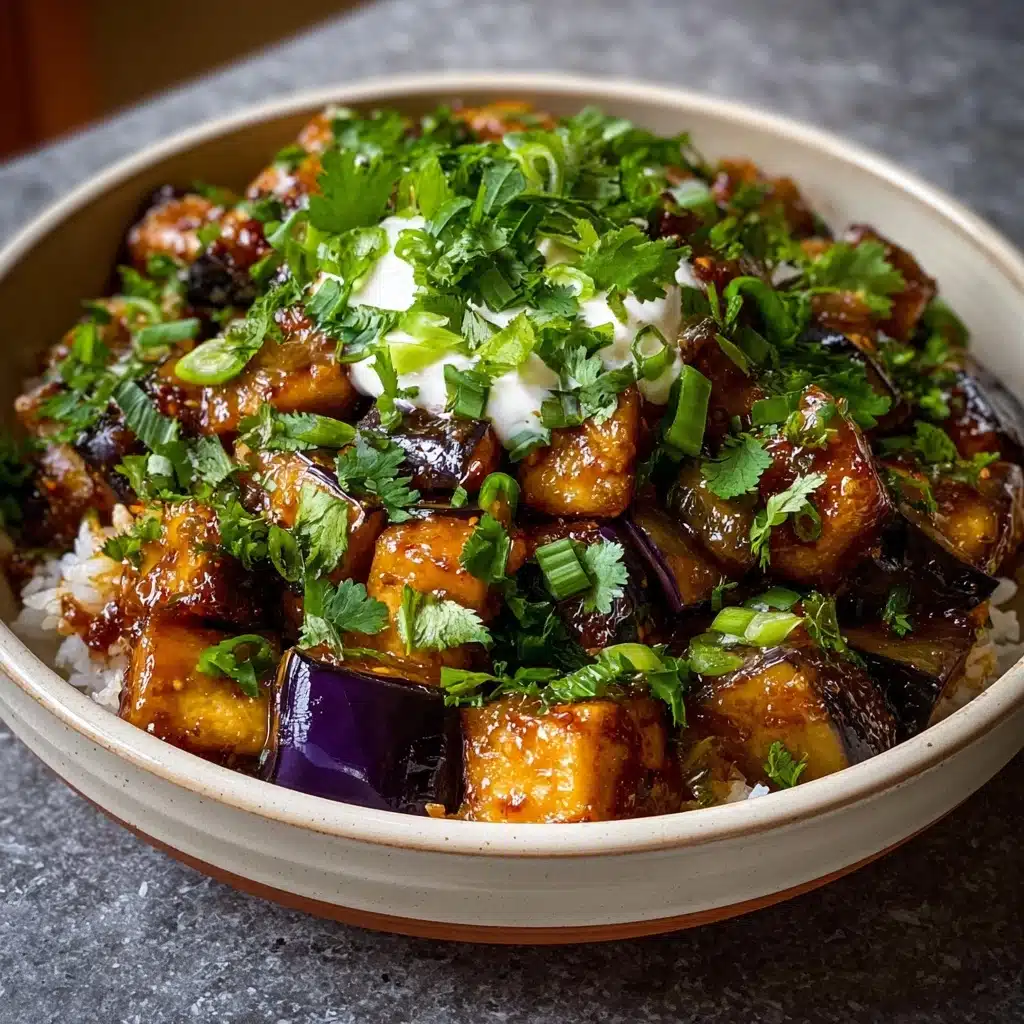Spicy Sichuan Eggplant Recipe
If you’re seeking a dish that’s equal parts bold, comforting, and bursting with umami, look no further than Spicy Sichuan Eggplant. This recipe transforms humble eggplants into gloriously tender strips, perfectly coated in a fiery, fragrant sauce that’s just the right balance of savory, tangy, and slightly sweet. Every bite is layered with rich aromatics and that signature tongue-tingling Sichuan heat—making it the kind of recipe you’ll crave again and again.

Ingredients You’ll Need
The ingredient list for Spicy Sichuan Eggplant is refreshingly short and straightforward, but each item brings something essential to the table. From building that signature “mala” (spicy-numbing) flavor to giving the eggplant its silken texture and gorgeous glossy color, here’s what you’ll need:
- Eggplants: Choose medium ones for the best texture; they soak up flavor beautifully without becoming mushy.
- Vegetable oil: Ideal for stir-frying, helping the eggplant achieve that lightly crisp, golden exterior.
- Garlic: Minced fresh garlic adds pungent depth and rounds out the sauce.
- Ginger: A must for true Sichuan flavor, lending brightness and warmth.
- Green onions: Add crunch and a pop of color, plus fresh onion-y bite at the finish.
- Soy sauce: Brings salty, savory umami to anchor the sauce.
- Rice vinegar: Keeps things lively with a tangy hit that balances the richness.
- Chili paste (doubanjiang): The heart and soul of Spicy Sichuan Eggplant, infusing every bite with heat and fermented complexity.
- Sesame oil: Just a touch for rich nuttiness and aroma.
- Sugar: Balances the spicy and sour elements so every flavor shines.
- Vegetable broth or water: Helps build a luscious, slightly saucy consistency.
- Cornstarch slurry: Thickens the sauce to the perfect clingy, glossy finish.
- Sesame seeds: For garnish—adds crunch and classic sesame flavor.
- Fresh cilantro (optional): Adds a fresh herbal note to brighten up each serving.
How to Make Spicy Sichuan Eggplant
Step 1: Prep the Eggplant
Begin by slicing your eggplants into inviting strips—think roughly finger-sized. Sprinkle them lightly with salt and let them rest for about 15 minutes. This little pause draws out excess moisture so when you cook them, they’ll turn golden and tender instead of watery. Once time’s up, pat them dry with paper towels for the best texture.
Step 2: Stir-Fry the Eggplant
Heat your vegetable oil in a skillet or wok over medium-high heat. Add the eggplant strips and stir-fry for 6 to 8 minutes. You’re looking for them to get beautifully soft, a bit caramelized, and just golden—this helps them absorb all the spicy goodness coming up. Remove the cooked eggplant from the pan and set aside for now.
Step 3: Create the Flavorful Sauce Base
In the same pan, add your garlic, ginger, and about half of your chopped green onions. Stir-fry these until fragrant—the aroma alone is worth pausing to enjoy. Next, add in your chili paste, soy sauce, rice vinegar, sesame oil, sugar, and vegetable broth. This combination is the backbone of Spicy Sichuan Eggplant, delivering the signature kick and tangy depth.
Step 4: Thicken the Sauce
Pour in your cornstarch slurry (that’s just the cornstarch mixed with water) and stir it into the sauce. In just a minute or so, you’ll notice the sauce thickening up and taking on a lovely shine. This thickened sauce is what’s going to coat every morsel of eggplant with incredible flavor.
Step 5: Bring It All Together
Return your cooked eggplant to the pan and toss everything gently until each piece is luxuriously coated. The eggplant will soak up all those spicy, aromatic notes, transforming into the irresistible Spicy Sichuan Eggplant you’ve been waiting for. Finish things off by topping the dish with a sprinkle of sesame seeds, the rest of your green onions, and fresh cilantro if you like.
How to Serve Spicy Sichuan Eggplant

Garnishes
One of the best parts about Spicy Sichuan Eggplant is piling on the garnishes. Sesame seeds lend nutty crunch, while a handful of freshly sliced green onions delivers extra freshness and color. If you’re a cilantro fan, a few sprigs scattered on top make every bite pop with herbal brightness. Don’t be shy—garnishing takes this dish from delicious to show-stopping.
Side Dishes
This eggplant is delightfully bold, so consider serving it alongside fluffy jasmine rice or steamed white rice to soak up the spicy sauce. It also pairs beautifully with a side of simple stir-fried greens or a cooling cucumber salad, which provide a crisp counterpoint to the heat. For a more lavish spread, add some steamed dumplings or a crispy tofu dish for real Sichuan restaurant vibes at home.
Creative Ways to Present
For a fresh twist, try serving Spicy Sichuan Eggplant in lettuce wraps or atop a grain bowl with brown rice and extra veggies. Turn it into a crowd-pleasing main by adding cubes of silky tofu, or stuff it into steamed buns for an irresistible vegan sandwich. However you serve it, those vibrant purple eggplant strips and glossy red sauce are guaranteed to steal the show.
Make Ahead and Storage
Storing Leftovers
If you have leftover Spicy Sichuan Eggplant, store it in an airtight container in the fridge. The flavors actually deepen as it sits, making tomorrow’s bite even more delicious. Just be sure to eat it within 3 days for the freshest taste and best texture.
Freezing
While this dish is best enjoyed fresh, you can freeze it if needed. Place the cooled eggplant in freezer-safe containers for up to a month. Keep in mind that while the flavors stay bold, the eggplant may become a bit softer after thawing.
Reheating
To reheat, simply warm the Spicy Sichuan Eggplant in a pan over medium heat, adding a splash of water or broth to loosen the sauce if needed. You can also microwave it (covered) in short bursts, stirring in between to prevent hot spots. Garnish again with fresh herbs and sesame seeds to liven it up.
FAQs
Can I use a different chili paste if I don’t have doubanjiang?
Absolutely! While doubanjiang does provide that signature Sichuan flavor and depth, you can substitute with sambal oelek, Korean gochujang, or any chili garlic paste you enjoy. Adjust the amount to match your heat tolerance.
Is Spicy Sichuan Eggplant vegan and gluten-free?
The recipe is naturally vegan if you use vegetable broth and plant-based toppings. For gluten-free, just make sure to use tamari or gluten-free soy sauce and double-check your chili paste ingredients, as some may contain wheat.
What’s the best eggplant variety for this dish?
Chinese or Japanese eggplants are ideal due to their thin skin and creamy flesh, which becomes silky-smooth when cooked. Regular globe eggplants work in a pinch, but peel them for the best results.
How spicy is this dish, and how can I adjust it?
Spicy Sichuan Eggplant has a medium heat level thanks to the chili paste. For less spice, use less paste or opt for a milder chili sauce. For more fire, add a pinch of crushed Sichuan peppercorns or extra chili paste—taste as you go!
Can I add protein to make it a main course?
Definitely! Stir in cubes of sautéed tofu, tempeh, or your favorite plant-based protein for an even heartier meal. If you eat meat, thinly-sliced chicken or pork can also be cooked before the vegetables and added back in at the end.
Final Thoughts
You truly can’t go wrong with Spicy Sichuan Eggplant—it’s a celebration of flavors and textures that sparks joy at the table every single time. Whether you’re new to Sichuan cuisine or already a longtime fan, give this recipe a try and see just how irresistible homemade spicy eggplant can be.






